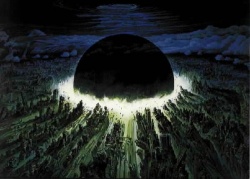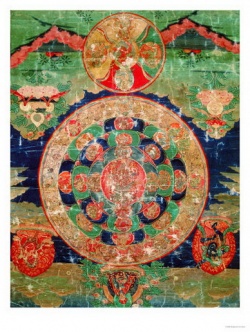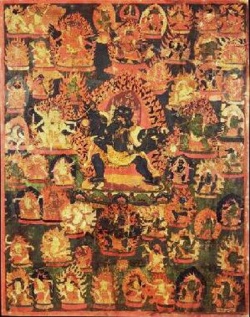Brief Introduction to Shithro or Zhikhro
The Mandala of 100 Peaceful and Wrathful Bardo Deities
Effective technique in training for the bardo is a technique of the vajrayana or secret mantra called the generation stage [Tib: bskyed rim), which refers to the visualization of the forms or bodies of various deities or yidams. These
deities include many that are peaceful, many that are wrathful, and so on. In general, regardless of the nature of the deity, this technique of visualizing yourself in the form of a deity is very effective in producing progress in meditation and in causing the blessing of these deities to enter into you.
Deity meditation is especially beneficial in training for the bardo, because in the bardo after one ís death a variety of appearances will arise, some of them seemingly threatening. Although these appearances are not in any way external to you and are
merely the projections of your mind, because of the confusion of your mind in that state you will tend to mistake them as external to you and, therefore, will tend to regard them as threatening, which will, of course, produce fear.
The important point to remember in the bardo is to recognize these appearances to be merely the projections of your mind. Therefore, working with the practice and visualization of a yidam such as Avalokiteshvara, the Buddha Amitabha, or
some other deity, is very helpful, because by doing these deity visualizations in this life, you cultivate the habit of recognizing appearances as projections of mind.
When you first practice these meditations, the form of the deity may be very unclear, but as you continue to practice, eventually you are able to generate a clear image. Sometimes, though the image is clear, it may initially still be unstable, but if you
continue to practice, it will not only be clear but will also become a stable image. This comes about simply through becoming accustomed to the practice itself.
When you have cultivated a clear and stable image of the deity in this life, then through that habit you will generate an even clearer and more stable image of the deity in the bardo, because the
appearances or projections of mind are much more vivid in the bardo. When this especially vivid and stable image of the deity arises in the bardo, it will serve as a remedy to the confused and terrifying projections which you would otherwise generate and will cause these to subside or to be purified.
Now, as for the preparation that is required in order to attain liberation at this point in the bardo, while it is true that the wrathful deities and peaceful deities in these various displays, such as the display of primordial purity and so forth,
will appear for everyone, for someone who is not accustomed to this practice, these appearances will flash by very briefly, making it very difficult for recognition to occur. Therefore, the primary factor in the recognition of these deities and other appearances is the practice of meditation.
The particular form of meditation that prepares you for this particular bardo is based upon the idea of coming to recognize these one hundred peaceful and wrathful deities as nothing other than your own display or your own projection, coming
to recognize that they are not external to you. Now, in the bardo of dharmata, when the peaceful and wrathful deities appear, they do appear more or less in front of you, as though they were external to you. But they appear that way because these deities have always, during your life, resided inside your body [and have thereby been obscured to you]. The approach to practice here [in this
life to prepare you for this phase of the bardo) is to recognize that these one hundred peaceful and wrathful deities exist naturally, or are spontaneously present, within your own body.
The essence of these one hundred deities is the Buddha Vajrasattva, and the reason that his mantra has one hundred syllables is that his mantra is the essence mantra of the one hundred peaceful and wrathful deities. In fact, it is for that reason that this mantra is so effective in the purification of wrongdoing and obscurations. So the practice
associated with [preparation for] this phase of the bardo is to visualize yourself as Vajrasattva and to think that in the center of your heart, in the midst of an expanse of swirling rainbow light and rays of rainbow light, are the forty-two peaceful deities the dharmakaya Samantabhadra, together with the five male and five female buddhas, the eight male and eight
female bodhisattvas, and so on all of these actually present within your heart in the midst of an expanse of rainbow light and spheres of light and so forth.
At the same time you think that inside your skull, in your brain, are actually present the fiftyeight wrathful deities in the form of brilliant light and drops of light, which are found within the various channels of the brain. Also you think that in the center of your throat, inside the various channels of the throat, are the ten
male and ten female vidyadharas, in appearance neither particularly wrathful nor particularly peaceful, and, therefore, referred to as semi-wrathful. You visualize these in the throat of yourself in the form of
Vajrasattva. The vidyadharas are also found in the midst of an expanse of rainbow light and drops or spheres of rainbow light.
By visualizing these deities with their individual colors, costumes, scepters, and so on, inside your body, as clearly as possible, then, through the habit of doing so, when they come to actually appear before you in the
bardo, you will not be terrified by them, but through having the habit of considering them to be your own natural display, you will recognize them as not being external to you.
Now, the method that has just been presented uses the visualization of the peaceful and wrathful deities within your body in order to prepare you for the experience of the bardo. But, of course, when you actually die and go through the bardo, what you are experiencing is something that is just spontaneously present; it is not a visualization that you are creating. So,
therefore, there is another method for preparing for this phase of the bardo, which is called the practice of taking the bardo on the path or of taking the bardo as the path.
This method is connected with the fact that because you are dead and do not have a body, the appearances which arise in the bardo are unobstructed by physical embodiment and are, therefore, free to arise. While we are alive these appearances do not
ordinarily appear in the way they do in the bardo. Nevertheless, there is a way to work with them using your physical body while you are still alive. Essentially the technique consists of sitting up in a good posture, with your back straight and so forth, and then
closing your eyes extremely tightly, closing your eyes so tightly that the skin and muscles of the eyelids actually press on the orbs of the eyes.
At the same time, you clamp your teeth together tight enough to create a certain effect. Now, first, with regard to what you are doing with your eyes, when you do this, initially you will see nothing; you will just see darkness. But if you keep your eyes
tightly shut, and if you keep looking directly at what arises before your visual perception, you will start to see some light arising. It could be green or blue or yellow or red or a mixture of any of these.
Now, if you look at this light that is arising with a relaxed mind, then this light becomes clearer and clearer and brighter and brighter. And as you look at it, what you are experiencing is an appearance of light that has no physical source of manifestation. Therefore, it is called the empty light of dharmata itself. Looking at this light, you can experience
directly the fact that what you are seeing is free of coming from somewhere, of going anywhere, and so on. As you develop certainty of this, then the light itself starts to dissolve.


